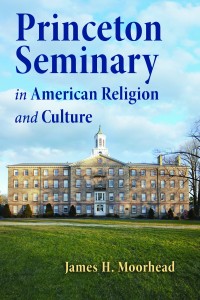 James H. Moorhead
James H. Moorhead
Princeton Seminary in American Religion and Culture
Grand Rapids, MI: Eerdmans, 2012.
Available at Amazon.com
In what is my best new read for 2013, James H. Moorhead’s history of Princeton Seminary is a fascinating read of American religious culture, Presbyterian history, and mapping of theological shifts in mainline America.
I learned much about how PTS was caught between Old and New School Presbyterianism. J.G. Machen is clearly the villain of the volume, while John A. Mackay is clearly the hero. Notably the Old Princeton types of Charles Hodge and B.B. Warfield are given a very sympathetic treatments, they were theological conservatives, but committed churchman. Though by the end, Moorhead regards their camp, of which the last was Charles R. Erdman, as the “ultra-conservatives” (422). Moorhead points out that from its inception PTS embodied a mix of Common Sense Realism, American patriotism, republican values, and evangelical Calvinism and it was the struggle to hold all these together which was the challenge for the Seminary in the following decades and even centuries.
To give a few tid bits of highlights: Charles Hodge went on a two year study tour of Europe without his family, doubt if my wife would let me do that! (102). About Joseph Addison Alexander, Charles Hodge’s colleague, it is said: “A bachelor until his death, he very nearly approximated the popular caricature of the total scholar, one whose highly structured lire was disciplined toward the goal of maximum intellectual effort” (105). The separation of church and state did not mean complete separation, but only neutrality between the various Protestant denominations according to Fred Hood (143). In an intriguing thought, reminding me of William Webb’s book, views of slavery and women go together. Charles Hodge rejected the claims of the Abolitionist movement because it seemed anarchic with its various opinions about the role of government and the rights of women (169).There’s a very interesting section on the first black students at Princeton including their struggle to gain quarters, but how they were treated well once they settled in (185-96). There is a great section on one African-America student named Matthew Anderson who had a particular successful ministry as church planter, social organizer, and educator. This is what he said to his Alma Mater:
We are a Presbyterian of the Presbyterians; the very fiber of our mental make-up being Presbyterian; before this nation came into existence our grand sires were in the Presbyterian Church, and we are firm in the belief that the Presbyterian church is the church for the Negro, but we are forced to say that before the Presbyterian or any other church can have any great success in getting hold of the Negro, the fountain head of that church, the schools of the prophets must be right towards him. For if the Theological Schools are wrong in their attitude towards the Negro, the young men they send out as ministers will be wrong in their attitude towards him, and if the ministry is wrong the people whom they teach will be wrong also, for like priest like people. Let Princeton Seminary, the fountain head of the Presbyterian Church turn about and make herself perfectly right in regard to the Negro (188).
Machen was opposed to black students being permitted to live on campus (196, 255). Whereas Hodge and friends were trying to defend a 17th century neo-Puritanism, others like Nevin and Schaff at Mercerburg were attempting to show the continuity of Protestantism with the broader Christian tradition (208-10). Except for a single decade, a Hodge was on the faculty of PTS from 1822-1937 (225). Geerhardus Vos did his Ph.D on textual criticism of Arabic manuscripts and moved from Western Seminary to Princeton because of troubles over his Supralapsarianism. In one criticism of Machen, he is regarded as being more Anabaptist rather than Presbyterian, envisaging the church as a volunteer society (358). Moving to the mid-twentieth century, John A. Mackay was born in Inverness, where I lived near, and embarked on a successful missionary career in South America (373). Scholars like Bruce Metzger and Otto Piper combined critical acumen and biblical authority together. For Piper, the authority of scripture was based on the fact that it contained the viva vox evangelli, the living voice by which God conveys knowledge of his saving will (438). Piper found himself often in no man’s land because “I had to endure the vitriolic attacks of fundamentalists who denounced me as a disguised modernist and the haughty disdain of liberals who could not understand that a critical scholar should believe that the Bible is the Word of God” (440).When Karl Barth came to Princeton in the early 1960s he was introduced to one of the newest faculty appointments, Freda Gardner, on meeting her he apparently exclaimed, “Vat? A voman?” (500).
A very entertaining read and a reminder that I must apply some day to do a sabbatical at the Center for Theological Inquiry.











